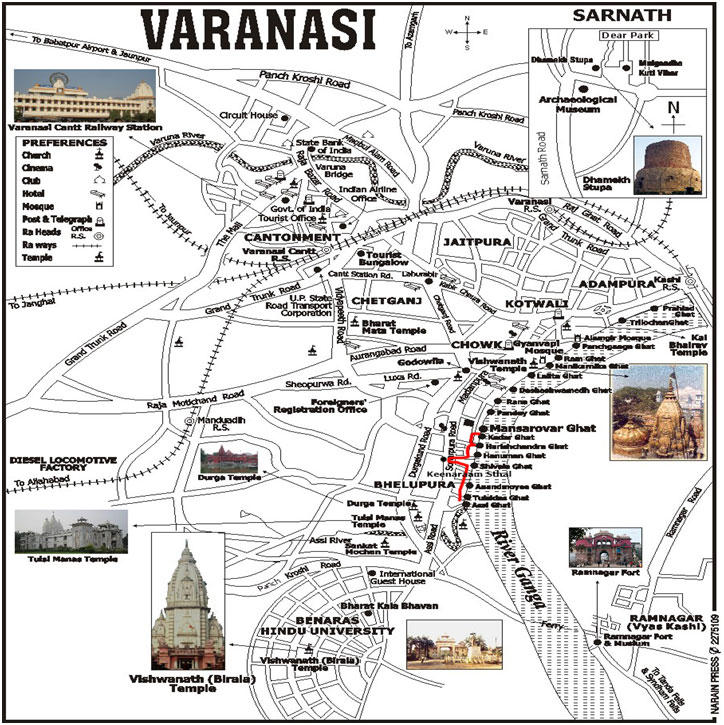
The spectacular 4 km sweep of the ghats is unique sight, best viewed at dawn, in that “soft first light” when the river and ghats have a timeless appeal. Life is almost panoramic detail unfolds here from dawn to dusk as a steady stream of devotees, swelling to thousands on auspicious days and perform rituals at the Ganga. The ghats are best approached by Dashasawamedha ghat, where boats are available on hire.

The Ganga ghats (river front) are the most popular pilgrimage spot of Varanasi and are centers of music and learning. There is a great tradition of Yatras in the holy city of Kashi and the most sacred path is that of Panchkoshi Parikrama, the fifty-mile path with a radius of five miles that cover 108 shrines along the way, with Panchakoshi temple as its main shrine.
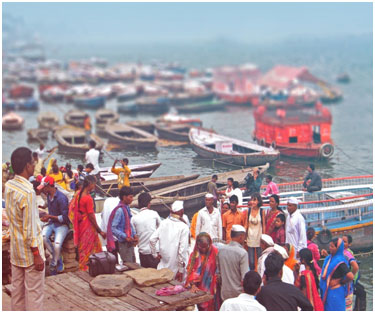 Many of the ghats were constructed under the patronage of the Marathas, Shindes (Scindias), Holkars, Bhonsles, and Peshwas. A morning boat ride on the Ganges across the ghats is a popular tourist attraction. The extensive stretches of ghats in Varanasi enhance the riverfront with a multitude of shrines, temples, and palaces built “tier on tier above the water’s edge”.
Many of the ghats were constructed under the patronage of the Marathas, Shindes (Scindias), Holkars, Bhonsles, and Peshwas. A morning boat ride on the Ganges across the ghats is a popular tourist attraction. The extensive stretches of ghats in Varanasi enhance the riverfront with a multitude of shrines, temples, and palaces built “tier on tier above the water’s edge”.
Every year, millions of pilgrims come to Varanasi. The three most important ghats are Manikarnika, Dasaswamedha, and Pancha-ganga. To bath at these three ghats is called Tri-tirtha Yatra. Also important are Asi Sangam and Varuna Sangam. To bathe in these five places is call Pancha-tirtha Yatra. You are supposed to bathe in these five ghats in a certain order. First you bathe in Asi Ghat, then Dasaswamedha Ghat, then the ghat by the Adi Keshava Temple near the Varuna River, then Pancha-ganga, and then Manikarnika. After taking bath at these five places, most pilgrims then go for darshan of Visvanath, Annapurna, and Sakshi Vinayaka (the witnessing Ganesh). It is said that if you bathe in these five places, all in the same day and in this order, you will not get another material body. You can do Pancha-tirtha Yatra by boat, but it is better to do it by foot.
Varanasi has at least 84 ghats, most of which are used for bathing by pilgrims and spiritually significant puja ceremony, while a few are used exclusively as Hindu cremation sites.
- ASI GHAT
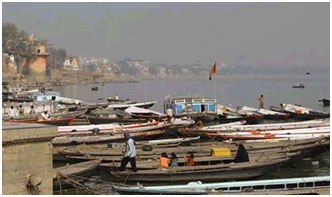
Asi Ghat is an important ghat of Varanasi traditionally constitutes the southern end of conventional city. Numerous references about this ghat are found in early literature. The confluence place of river Ganga and Asi is known as Asi or Assi ghat. In Kashi khand, it is said that one gets pious credits of all the Tirthas (religious places) by taking a dip here. It is said that the saint Tulasi Das sat here and written Ramcharitmanas. After nineteenth century, Asi Ghat was divided in five Ghats i.e. Asi, Gangamahal (I) Rewan, Tulasi and Bhadaini.
- GANGA MAHAL GHAT(I):
Ganga Mahal ghat is named after a palatial building of Ex-Maharaja of Banaras towards the northern end of Asi ghat.
- REWAN GHAT:
Rewan Ghat is an extended part of Assi Ghat and its building was constructed by Lala Mishir, royal purohit of King Ranjit Singh of Punjab. There is very little significance of cultural and social activity here.
- TULSI GHAT:
It is named after the great poet Tulsidas (1547-1622 A.D.) who wrote Ramcharitmanas. Earlier it was known as Lolark ghat. This ghat is associated with a number of important activities such as bath of Lolarkkunda (to get sons and their long life) and bath to get rid of leprosy.
- BHADAINI GHAT:
This ghat has standing wall constructed by brick and stone. Bathing or religious activities are not performed here. It has a huge pumping set of waterworks which supply water to whole city.
- JANAKI GHAT:
In 1870 A.D. Maharani Kunwar of Sursand (Bihar) made this ghat. Earlier it was known as “Nagamber ghat”. It has a little religious importance but people bath since it is safe and clean.
- MATA ANANDAMAI GHAT
Earlier it was known as ‘lmalia Ghat’. In 1944 Mata Anandamai purchased this area from British. She made this ghat well built to run an ashram.
- Bachraj Ghat
The Jain Ghat or Bachraj Ghat is a Jain Ghat and has three Jain temples located on the banks of the river.
- JAIN GHAT:
Before 1931 Jain ghat was the part of Bachraja ghat. Later Jain community made a strong ghat and named it as Jain ghat. On the southern end Jain communities take bath and perform their regular activities.
- NISHAD GHAT:
Earlier it was a part of Prabhu Ghat till first half of twentieth century. Now a large number of boatmen with their small boat & nets can be seen. Ghat has one Nishad raj temple which in fact was constructed by boatmen families only a few years back.
- PRABHU GHAT:
This Ghat was made in the earlier part of twentieth century by Nirmal Kumar of Bengal. Most of the boatmen families are living here. Normally washermen wash clothes here. Ghat has very little social cultural significance.
- PANCHKOTA GHAT:
On the northern end of Prabhu ghat, a palatial building and a ghat was constructed by King of Panchakota (Bengal) in the latter half of nineteenth century. A series of thin stairs from ghat lead to palatial building where two temples are situated.
13. CHETA SINGH GHAT:
It is a historical fortified ghat. The place has witnessed a fierce battle between the troops of Warren Hastings and Chet Singh in 1781. A.D.
Originally this Ghat was known at ‘Khirki Ghat; Now it has four parts known as Cheta Singh, Niranjani, Nirrvani and Shivala Ghat. Due to sharp current of Ganga, people avoid bathing here.
- NIRANJANI GHAT:
This ghat belongs to Naga Saints who established ‘Niranjani Akhara’ in 1897.
15. MAHANIRVANI GHAT:
It is situated on north end of Nirvani Ghat. It is named after Mahanirvani sect of Naga Saints. The famous Akhara is situated here.
16. SHIVALA GHAT:
It has been important ghat in early times. At present one witnesses a colossal building constructed by Nepal King Sanjay Vikram Shah,a Shiva Temple and one Brahmendra Math established by Kashiraj. There is no significant cultural activities here.
- GULARIA GHAT
This Ghat was named after a huge Gular tree which is not currently present.
- DANDI GHAT
This ghat is predominated by the Dandi ascetics carrying stick in their hand. This ghat is quite clean and worth taking bath.
- HANUMAN GHAT
It is believed that great saint Tulsidas has established a Hanuman temple here during eighteenth century which made it famous as Hanuman ghat. The ancient name of this ghat was Ramesvaram ghat which was established by Lord Ram himself. At present, it is inside boundary of Juna Akhara. Many renounced (vairagi) ascetics live in the temples. The neighbourhood is dominated by South Indian residents.
- PRACHINA (OLD) HANUMANANA GHAT:
This Ghat is associated with a great bhakti saint Valabha (C.E.1479-1531), who laid the philosophical foundations for a great resurgence of Krishna bhakti (Eck 1882: 223). His birth day is celebrated here on 11th dark-half of Vaisakha (April-May).
- KARNATAKA GHAT:
This ghat was built by the state of Mysore (now known as Karnataka) in early twentieth century (C. 1910). There also is a shrine of Ruru Bhairava, one of the 8th Bhairavas protecting the city from eight directions.
- HARISH CHANDRA GHAT:
This ghat is named after the famous King Harish Chandra, who served at the cremation ground here for the preservance of truth and charity but at the end the gods rewarded him and restored his lost throne and his dead son to him. This is one of the two cremation ghats, and sometimes referred as Adi Manikarnika. In 1986-87, an electric crematorium was also opened here. On the top in the temples, there are deities of Harischandrsvara, Rohitesvara, Adi Manikarnikesvara & Vrddha Kedara. In c. 1740 Narayana Diksit, a religious guru of Peshwas renovated this ghat.
King Hariscandra was famous for never refusing a guest and never telling a lie. He was a worshiper of Brahma. Indra told Brahma that he believed that Hariscandra’s devotion was not as strong as he made it appear to be. So in order to prove that it was, Brahma disguised himself as a brahmin priest and asked the king for his entire kingdom. Hariscandra gave it. In order to give the payment (daksin) to priest for performing some rituals, the king became a worker at the crematorium at this ghat. His wife was sold to a seller of flowers. When his son died of a snakebite his wife brought him to the burning ghat where her husband was working. Because she had no money to pay the cremation fee, she ripped her sari in half to pay the fee. Brahma then restored the son back to life and gave the king back his kingdom. He also told Hariscandra that this ghat would be especially sacred and that it would be named after him.
- LALI GHAT:
At the upper side there are temple of Lambodara Cintamani and Jyestha Vinayaka, Kiratesvara, Jayanta Siva Lingam and Maha Laksmi. The vicinity is dominated by washermen.
- VIJAYANAGARAM GHAT:
This was made strong in 1890 by the Vijayanagaram State of South India. At the top of it, Svami Karapatri Asrama is present. Close by to this building are the shrines of Nilakantha and Nispapesvara.
25. KEDAR GHAT :
This ghat is the site of Haramapapa tirtha. At the top exists the temple of Kedaresvara, the patron deity of the southern sacred segment.
- CAOWKI GHAT :
This ghat is famous for the huge pipala (Ficus religiosa) tree at the top of the steps and probably relics of the early Buddhist period”. Closeby to this tree is the shrine of Rukmangesvara, and at some distance lies Naga Kupa (“Snake Well”).
- KSEMESVARA / SOMESVARA GHAT :
Its old name was Nala Ghat, and was built in early eighteenth century. The followers of Kumarasvami made a monastery in 1962 at the upper – side of the steps. The neighbourhood is dominated by Bengali residents.
- MANASAROVARA GHAT :
At the top of this ghat there is a sacred pond, in replicated form representing the famous sacred lake of the same name lying in Tibet.
- NARADA GHAT :
The old name of this ghat is Kuvai Ghat. This was constructed by Dattatreya Svami, a monastery chief in 1788. The four important images in the upper side are Narada, Atri, Vasuki and Dattatreyesvara.
- RAJA GHAT :
Formerly known as Amrita Rao Ghat, this was firstly made by the first Maratha chief Bajirao Balaji in 1720.
- KHORI GHAT:
Also known as Ganga Mahal Ghat, this was made strong in late nineteenth century by Kavindra Narayana Singh.
- PANDEY GHAT:
In 1805, this ghat was built in honor of a famous wrestler, Babua Pande, established a wrestling site (Akhara).
- SARVESVARA GHAT :
The Ganga Kesava Tirtha and Servesvara deities are near the ghat.
34. DIGPATIA GHAT :
This was erected in c.1830 Raja of Digpatia (Bengal).
- CASAUTTI GHAT :
This ghat is described in the Kasi Khanda (61.176-177) with respect to yogini tirtha and Agatsya tirtha. Another important occasion of attraction is the evening on the day of Holi-a colorful festival showing start of Caitra-1, when homage ritual is performed at the ghat.
- RANA MAHALA GHAT :
In fact, this is an extended part of the preceding ghat, and also made by king of Udaipur in c.1670.
- DARABHANGA GHAT :
Together with magnificent building along the ghat and a grand Siva temple in Nilakantha area, the king of Darabhanga (Bihar) made them in 1915.
- MUNSI GHAT :
The ghat was built by Sridhara Narayana Munsi in 1912 as an extended pare of Darabhanga Ghat. He was a finance minister in the State of Darabhanga. After his death in 1924 this portion of ghat was named in his honor.
- AHILYABAI GHAT :
At the place of an old site of Kevelyagiri ghat, in c. 1778. Queen Ahilyabai Holkar of Indore made this a strong ghat. For the first time, name of a person was added after the ghat. She was also responsible for re-building the Visvesvara temple, as exists at present, in 1777.
- SITALA GHAT :
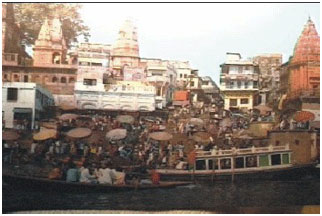
This is the southern extension of Dasasvamedha ghat, where exists Dasasvamedha Tirtha and deities of Dasasvamedhesvara and Dasaharesvara.This ghat is named after the famous sitala temple. On the eighth light- half of lunar months of Caitra, Vaisakha Jyestha and Asadha (march – July) and Asvina (Sept–October) people celebrate the festival of Sitala Asthami (“8th day” ). The same festivities also occur at (adi) Sitla Ghat in the north. Another important occasion at this ghat is the special worship by the newly married couples and their close family members come here for the Ganga worship ritual followed by rituals in the Sitala temple.
- DASASHWAMEDHA GHAT
This is the busiest and the ancient most referred ghat. Lord Brahma performed the ten-horse sacrifice (dasa-asvamedha) at this site. The southern part of the ghat was made strong in 1740 by Bajirao Peshwa-1, and late in c.1774 by Ahilyabai Holkar of lndore. This is the main bathing ghat in town, so it can be extremely crowded. The area around this ghat is the main center of activity in the city, especially for pilgrims and tourists. This ghat is full of pilgrims bathing in the holy Ganges. It is said that Lord Brahma performed a ‘Ten Horse Sacrifice’ here for king Divodasa. Das means ‘ten,’ aswa means ‘horse,’ and medha means ‘sacrifice.’ It is said that bathing here gives the same merits as received by doing the ‘ten horse sacrifice’ that were performed here. On certain auspicious days up to 30,000 pilgrims may take bath here.
Ganga-puja is performed every evening on Dasasvamedha Ghat.

- PRAYAG GHAT :
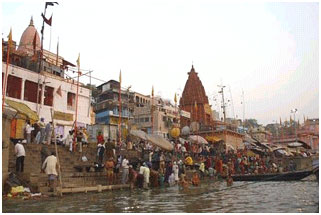 This ghat (old Prayaga Tirtha) together with shrine of Prayagagesvara replicates the existence of Prayaga/ Allahabad in Varanasi.
This ghat (old Prayaga Tirtha) together with shrine of Prayagagesvara replicates the existence of Prayaga/ Allahabad in Varanasi.
Prayaga, known as “Tirtharaja” (king of Tirthas), lies at the confluence of the Ganga, the Yamuna and the invisible Sarasvati rivers. It is commonly believed that doing rituals and taking sacred bath here provide exactly the same religious merit as those at Prayaga (80 km away in the west).
- RAJENDRA PRASAD GHAT :
In memory and honor of the first president (1950-1962) of India, Rajendra Prasad (1884-1963), this ghat was renamed In 1979. It was made strong by the Municipal Corporation of Varanasi. In fact, this ghat was northern extension of Dasasvamedha Ghat.
- MAN MANDIR GHAT :
The old name of this ghat was Somesvara, but in c.e. 1585 when Raja Savai Mana Singh (of Amber) made his palace and ghat this is named after him.
- TRIPURA BHAIRAVI GHAT :
This ghat is named after the Tripura Bhairavi Shrine, consort of Lord Tripuresvara whose deity also exists there. Another important shrine is of Varahi, one of the nine mother-goddesses.
- MIR GHAT :
This ghat represents two old sites of Jarasandhesvara and Vrdhaditya, which were converted by Mir Rustam Ali in 1735.
- PHUTA/ NAYA GHAT :
This was an old site of Yajnesvara Ghat and was made strong by Svami Mahesvarananda in mid nineteenth century.
- NEPALI GHAT :
Above it a stair- case leads to the Nepalese temple, a very picturesque building, half-hidden by magnificent tamarind and pippal trees. The area is dominated by Nepalese residents (Nepali Khapra).
49 LALITA GHAT :
This ghat is named after the famous goddess Lalita in Kasi and also in Prayaga.
- BAULI/ UMARAOGIRI/ AMROHA GHAT
The old name of this ghat was Raja Rajesvari Ghat.
- JALASAYI GHAT
The name itself indicates “putting dead body into water” as part of ritual before putting the corpse on the funeral pyre. In the mid- nineteenth century the nearby building and the ghat were built.
- KHIRKI GHAT :
The name of the ghat literally means “the windows (Khirki)” from where attendants can watch the cremation.
- MANIKARNIKA GHAT :
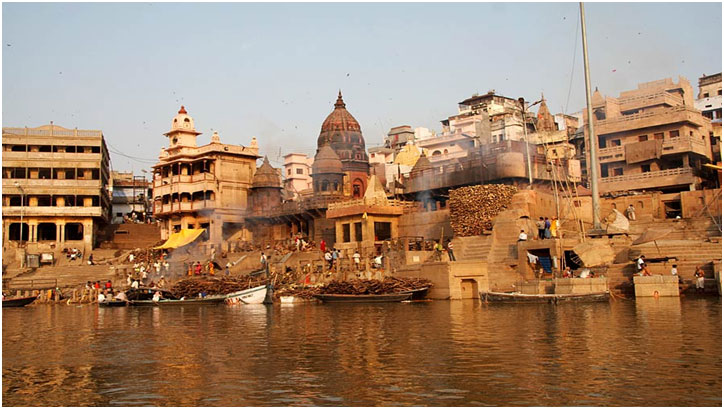
This is popularly called as “the great cremation ground” (Mahasmasana).
It is mentioned that Lord Siva chants Taraka mantra of Lord Rama (“Prayer of the crossing cycle of birth and death”- Holy name of Lord Ram) in the ear of the whomsoever dies in Varanasi. Mani-karnika means “Jewelled Earring.” It is said that this name was given because while dancing, Lord Siva’s earring fell into the well just next to the ghat. In the vicinity are shrines of Manikarnikesvara (a little far in the upper side of the lane), Mahesvara (open air lingam at the ghat) and Siddha and Manikarna Vinayakas. The temple of Manikarnikesvara is the approachable from the ghat by taking a steep ascending lane south of the Kunda.
Manikarnika Ghat is considered the holiest of all the ghats. Normally the cremation ground is outside of town, as it is polluted. Here the burning ghat is in the middle of the city, because death in Varanasi is considered a great blessing. It is said to be bad luck to mourn or cry for the dead. At any given time there may be half a dozen bodies burning here. The bodies are first placed in the Ganges before being burned.
Manikarnika Kund is said to be so ancient that it was present before King Bhagiratha brought the Ganges to Varanasi. This kund is also called Chakra-Pushkarini Kund or “Discus Lotus-Pond.” The well is said to come from a source separate from the Ganges, an underground river that comes directly from Gaumukh, which is the source of the Ganges. It is said that this well was dug by Lord Vishnu with his disc (chakra) and filled by water as his first act of creation. It is said that at one time this kund was a very large lake. There is an image of Lord Vishnu in the northern wall of the kund. Offerings of milk, sandalwood, sweets, and bilva flowers, which are sacred to Siva, are thrown in the well. In October or November, there is a good chance the kund will be covered by dirt, because when the Ganges floods during the rainy season (June-Sept), dirt from the Ganges covers up the kund. The kund is dug out each year in November.
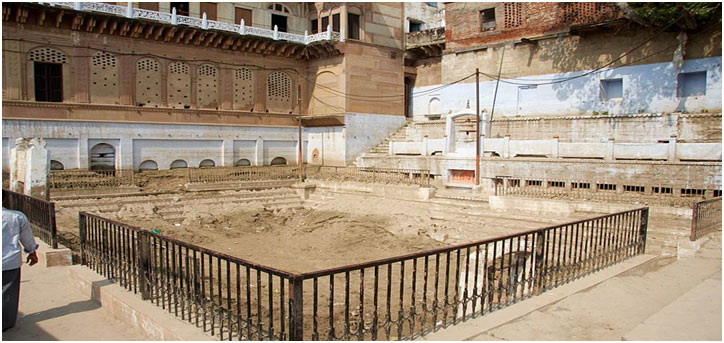
Lord Vishnu’s footprints are located at Chakra-Pushkarini, which is between Manikarnika kund and the river. For 7,000 years Lord Vishnu is said to have stayed and performed tapas on this spot.
- BAJIRAO GHAT :
Bajirao Peshwa built this ghat in c. 1735, which is how it is named after him. Presently this is assumed to be a part of the Scindhia ghat.
- SCINDHIA GHAT:
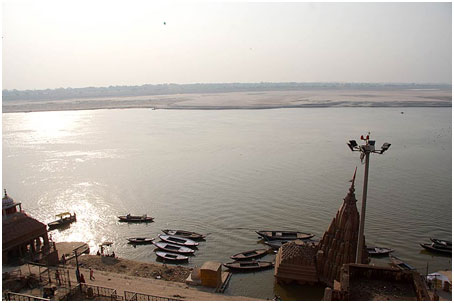
Formerly it was known as Viresvara ghat, after the temple of same name lying at the top. In 1937 Daulatarao Scindhia made the entire ghat strong. The shrines of Vasistha and Vamadeva, and Atmaviresvara are at the top. The Paravata tirtha lies in the close by Ganga river. On this ghat, is a partially submerged Siva temple. Agni, the god of fire, is said to have been born near this ghat.
- SANKATA GHAT:
Its old name was Yameshvara Ghat after the name of the shrine.
- GANGA MAHAL GHAT (2):
This is an another ghat of the same name. This, in fact, is an old part of Yamesvara Ghat.
- BHONSALE GHAT:
In c. 1780 Maratha king ‘Bhonsala’ of Nagpur made this ghat.
- NAYA GHAT:
In Prinsep’s map of 1822 this was named as Gularia Ghat and perhaps was made only a few years before.
- GANESA GHAT:
This was formerly known as Agnisvara ghat after the Agni tirthan in the stream.
- MEHTA GHAT:
After the construction of V.S.Mehta hospital (1962) this is known. The Varanasi Municipal Corporation made this ghat strong in 1960s. This is a tirtha with a mixture of three waters along this ghat: Maitravaruna, Marutta and Iksavaku.
- RAMA GHAT:
Two other close by waters along this tirth are Kala Ganga and Tamra Varaha. The famous Vedic school of its own kind, the Sanga Veda School, is situated close to it. Special celebrations are performed on the occasion of Rama’s birth on nineth light-half of Chitra (March-April) and Ganesa’s birth on fourth dark-half of Bhadrapada (August-September). The temple of Rama and Badri-Narayana is also a notable shrine at the ghat.
- JATARA GHAT:
Jatara Ghat came into being in 1766 and was created during renovations of all ghats by Peshawas of Maharashtra.
- RAJA GWALIOR GHAT:
Both of these ghats and also Rama ghat were erected by the patronage of Madhorao Peshwa in c. 1766.
- MANGALA GAURI GHAT:
At the top of the ghat in temple compound there are images of Gabhastisvara, Mangala Gauri and Mangala Vinayaka.
- VENIMADHAVA GHAT:
This is the part of the Pancaganga ghat and also known as Bindu Madhava ghat after the name of the famous tenth century temple.
- PANCHAGANGA GHAT:
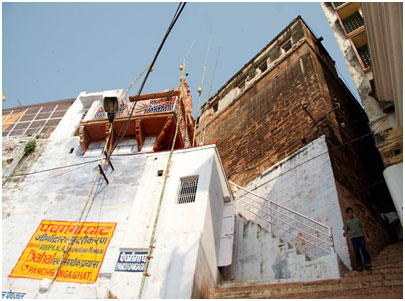
Beneath this ghat, the Ganges, Yamuna, Sarasvati, Kirana and Dhutapapa Rivers are said to meet. Among which only the first one is visible and rest are vanished or assumed in the form of manifestation. It is one of the five main ghats in Varanasi. It is considered especially auspicious to bathe here during the month of Karttika (Oct-Nov) and most importantly on the full moon day of Karttika. The merit and glory of this ghat are described in an eleventh century text and also in the Kasi khanda (59;116-144). This was the chief resort of a great teacher of Vedanta, Ramananda (1299-1411) to whom Kabir (1398-1623), a great reformist and bhakti poet, accepted as guru. One can find Ramananda’s monastery here.
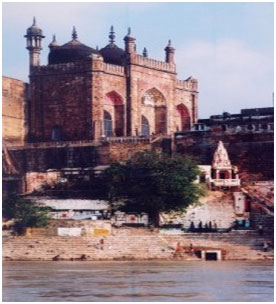
Tulsi das Goswami (1547-1623) was initially living (c.1580s-1590s) at this ghat where he composed the famous writing, the Bindu-patrika (“The petition to Rama”), describing the glory of Bindu Madhava temple.
At this ghat, is the large Alamgir mosque built by Aurangzeb in the 17th century. After he destroyed the major Bindu Madhava temple that used to be here. The present Deity of Bindu Madhava is in a small temple near by the mosque. It is located just above the Pancha-ganga Ghat. If you are taking a boat by yourself, you can have the boat stop here and walk up to the temple.
There is a beautiful story of How Lord Vishnu is known as Bindu Madhava.
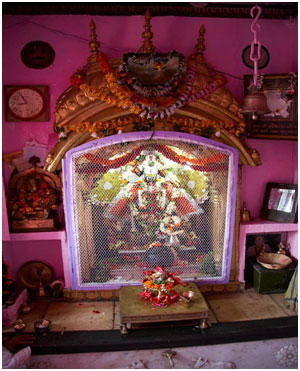
As per the directions of Lord Shiva, Lord Vishnu travelled from Mandarachal to Kashi with a divine mission of making King Divodas leave Kashi (Kindly read also below section “Story of King Divodasa”).
After having accomplished his mission, Lord Vishnu was enjoying the serene beauty of Kashi, Pancha Nada Teerth, Padodak Teerth and other places. At Pancha Nada Teerth, he came across one extremely lean looking sage who was undergoing austerity (tapas).
Lord Vishnu in his divine form approached the sage whose name was Agni Bindu and stood in front of him. On seeing the Lord personally appearing, he was ecstatic and he prostrated before the Lord. The sage started singing praises of the Lord.
The sage addressed the Lord by various names like Mukunda, Madusudan, Madhav, Narayan, Rama Bhadran, Chatur Bhuj, Janardhan etc. The sage also mentioned that those who worship Lord Vishnu with Tulsi leaves or garland made of Tulsi Leaves will get lots of blessings.
After having sung all praises about Lord Vishnu, Agni Bindu Rishi stood silently with folded hands. Lord Vishnu asked the sage to seek any divine boon. The sage sought only one thing: that Lord Vishnu should always be available for his worship in the vicinity of this Pancha Nada Teerth.
Lord Vishnu granted it accordingly. He further stated that Kashi is a Punya Kshetra and devotees can achieve several kinds of Siddhi by staying in Kashi. Lord Vishnu further told that he would stay in Kashi as long as Kashi is present and there will be no destruction of Kashi as this holy city is situated atop the Trishul (Trident) of Lord Shiva. Therefore, even Maha Pralay (great deluge) cannot destroy the city.
Agni Bindu Rishi was extremely happy at this and sought one more divine boon from Lord Vishnu. He desired that Lord Vishnu should not just appear here but also appear with a name connected to him.
Lord Vishnu agreed to the request of the sage. He stated that henceforth he (Lord) will be known as Bindu Madhav in Pancha Nada Teerth. By his presence, the Teerth will be extremely sacred and devotees who bathe in this Teerth and honour learned persons, will be blessed with wealth and prosperity.
The Teerth, which is capable of cleansing all sins, will be called as Bindu Teerth. A person may have committed various sins, knowingly or unknowingly, but if during the Kartik Month, he religiously bathes in Pancha Nada Teerth and worships Bindu Madhav, he will attain mukti.
Lord Visweshwar Shiva himself regularly takes bath in this Teerth during Kartik Month.
Lord Vishnu further stated that He (Lord) was called as Aadi Madhav in Sat Yug, as Ananda Madhav in Tretha Yug, in Dwapar Yug as Shree Madhav. In Kali Yug the Lord will be known by the name of Bindu Madhav.
Agni Bindu Rishi was extremely happy for the direct worship of Lord Vishnu and he prostrated before the Lord.
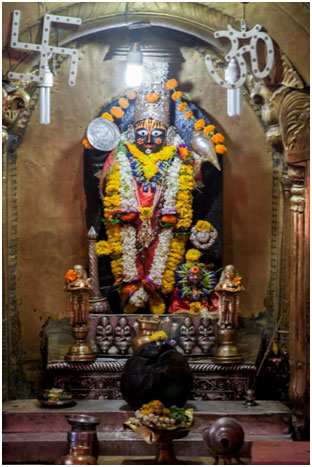
Utsav Murti of Lord Bindu Madhav was found in the holy Ganga at Varanasi by Shri Madhavendra Thirtha Swami while he was having bath at the ghats. During the period of Shri Madhavendra Thirtha Swamiji, the main deity of Lord Bindu Madhav was transferred to the Moola Mutt of Kashi Mutt for protection from the invaders. However the Utsav murti was missing for long. Shri Madhavendra Thirtha Swamiji lovingly reinstalled this utsava murti. It is this Utsav murti of Lord Bindu Madhav who partakes in all the utsavs. Swamiji not only restarted the different Utsavs – but Swamiji is credited with starting the Bramha Rathothsava on Ram Navami. Swamiji also got the Atri Gotra family of priests from Cochin and started the Pariyaya system between Vatsa Gotra and Atri gotra families.

Lord Sri Caitanya Mahaprabhu also bathed at Pancha-ganga Ghat and visited the old temple of Bindu Madhava. While staying in Varanasi on His way back from Vrindavan, Sri Caitanya became the guest of Tapana Misra and Chandrasekhar. It was here that he met Srila Sanatana Goswami.(Kindly read also below section “Lord Chaitanya Mahaprabhu visit to Varanasi”).
Sri Chaitanya also converted Prakasananda Sarasvati and his followers while staying at Varanasi.
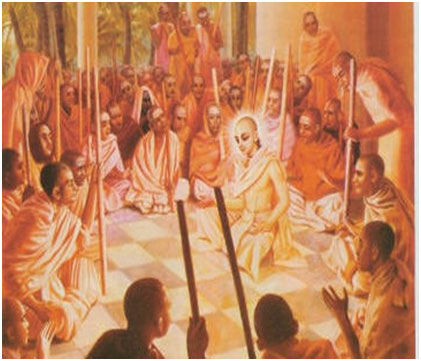
- DURGA GHAT:
The name derived its association with the Durga temple.
- BRAHMA GHAT:
This is named after the temples of Brahma and Brahmesvara.
- BUNDI PARAKOTA GHAT:
Formerly it was known as Raja Mandira Ghat. In 1580, king of Bundi, Raja Surajana Hada made this ghat. In its vicinity at the top exists the shrines of Sesa Madhava and Laksmi Nrsimha.
- (ADI)SITALA GHAT:
This ghat is named after the old temple of Sitala, known as “Badi” (elder) sitala.
- LALA GHAT:
This ghat was erected by a rich merchant in 1800 after whose name it is now known.
- HANUMANAGARDHI GHAT:
It represents the famous site of Hanumanagadhi in Ayodhya, the birth place of Rama.
- GAYA/GAI GHAT:
At the ghat there is a huge image of a cow (gaya/gai), symbolizing the earth, that is how the ghat is known as Gaya Ghat.
75. BADRI NAYARANA GHAT:
The associated sacred shrines are Nagesavara tirtha, Nagesvara, Nagesa Vinayaka and Nara-Narayan Kesava. The last shrine is originally at Badrinatha, that it how the name of ghat derives: Badri (the site) and Narayana (the deity). On the occasion of full-moon day of pausa (December-January), a special festivity in honor of Vishnu in the form of Nara-Narayana is celebrated.
76. TRILOCANA GHAT:
The name derives after famous deity of Shiva, Trilochana (“Three-Eyed”), whose lingam is known as Trilocanesavara.
- GOLA GHAT:
Since late 12th century, this site was used as ferry point and was also known for a number of granaries (gold), from where the name Gola ghat derived.
- NANDESAVARA /NANDU GHAT:
This ghat in early 20th century was built by the local neighbourhood residents. There appears an Akhara (wrestling site) of the same name.
- SAKKA GHAT:
Most parts of the ghat are occupied by washermen.
- TELIANALA GHAT:
It known for an ancient sacred spot, Hiranyagarbha Tirtha. However later the area was dominated by the oil pressing caste (Teli) settled along a small drain (nala) meeting here, that is how the name derived.
- NAYA/PHUTA GHAT
In medieval digests a sacred water-front site, Gopratara Tirtha, and deity of Gopratatesvara are referred at this ghat. During 18th century, the ghat area became deserted (Phuta), but later it was renovated. This way the ghat was formerly known as phuta, and later as Naya.
- PRAHALADA GHAT:
This is named after Prahalada, a great devotee of Lord Vishnu. On fourteenth light half of Vaisakha (April-May), a grand festive celebration to honor the appearance of Nrsimha (“Lion-Man” incarnation of Lord Vishnu; i.e. fourth among the ten) is performed on massive scale in the temple of Prahaladesvara.
- RAJA GHAT:
Upto 1887 this was a famous ferry ghat. There are four water tirthas affiliated to this ghat: Sankhya, Uddalaka, Hayagriva and Nilagriva.
- ADI KESHAVA GHAT:
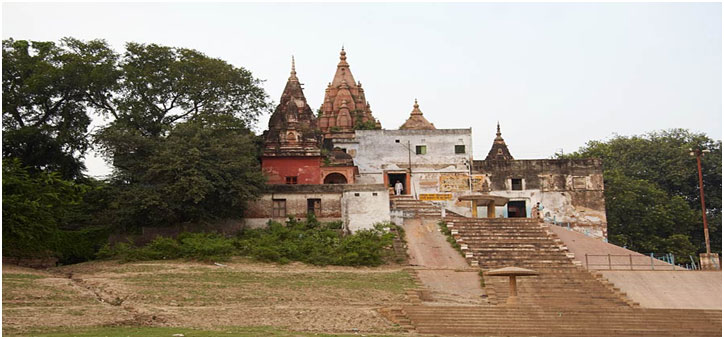
This ghat was also referred as Vedesvara Ghat.
This is assumed to be the oldest and the original (Adi) site of Lord Vishnu ( Kesava).
The Adi Keshava Vishnu temple is located where the Ganges meets the Varuna River, in the north of town.
The 5 holy spots represent the bodily parts of the Lord:
” Asi is the head; Dasasvamedha is the chest; Manikarnika is the naval; Pancaganga is the thighs; and Adi Kesava is the feet”. This reminds that Vishnu first placed his holy feet here in Varanasi. His foot prints (Carana Paduka) in the Adi Kesava temple symbolize that occasion; another foot prints are at Manikarnika Ghat.
The appearance day (Jayanti) of Vamana (“the Dwarf”; 5th incarnation of Vishnu among the ten) is celebrated on massive scale in the Adi Kesava temple on 12th light- half of Bhadrapada (August- September).
At the time of sunrise and sunset, one can see the natural beauty of reflecting colourful light in the Ganga. In the morning, the reflection of sunlight on the palatial buildings and in the evening the shadows of those building in Ganga make the scene unique which is more an aspect of experience than reading about it.

 Buddhists worldwide look upon India as the land of the Buddha and a visit to this country means a pilgrimage to those places sacred to the memory of the Enlightened One. After Buddha attained enlightenment in Bodh Gaya, he came to Sarnath. Here in the Deer Park, he delivered his first sermon, or in religious language, set in motion the wheel of law (maha- Dharmachakra Pravartan). On the day before his death, Buddha included Sarnath along with Lumbini, Bodh Gaya and Kushinagar as the four places he thought to be sacred to his followers.
Buddhists worldwide look upon India as the land of the Buddha and a visit to this country means a pilgrimage to those places sacred to the memory of the Enlightened One. After Buddha attained enlightenment in Bodh Gaya, he came to Sarnath. Here in the Deer Park, he delivered his first sermon, or in religious language, set in motion the wheel of law (maha- Dharmachakra Pravartan). On the day before his death, Buddha included Sarnath along with Lumbini, Bodh Gaya and Kushinagar as the four places he thought to be sacred to his followers.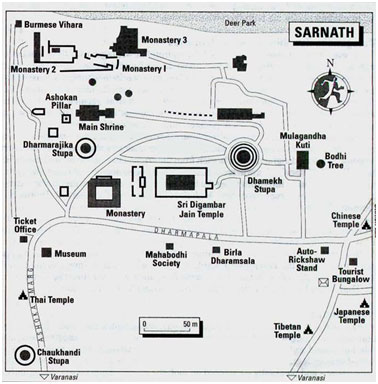
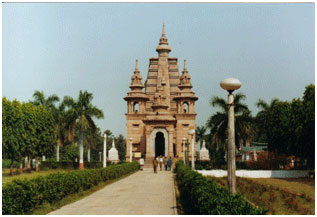 Chaukhandi is the first monument one encounters as one enters Sarnath. The most remarkable structure at Sarnath, is the cylindrical Dhamek Stupa, 28 mts in diameter at the base and 43.6 mts in height, built partly of stone and partly of brick.
Chaukhandi is the first monument one encounters as one enters Sarnath. The most remarkable structure at Sarnath, is the cylindrical Dhamek Stupa, 28 mts in diameter at the base and 43.6 mts in height, built partly of stone and partly of brick.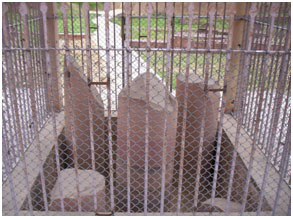 It is at Sarnath, the Ashoka pillar stands in front of the main stupa where Ashoka sat and meditated.
It is at Sarnath, the Ashoka pillar stands in front of the main stupa where Ashoka sat and meditated.
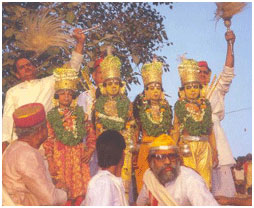
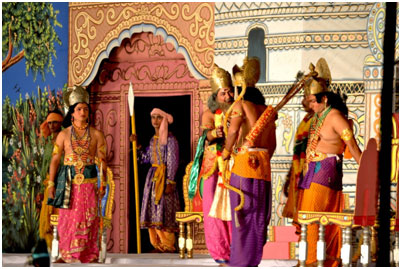
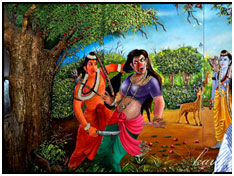 Showing a story from Ramayan in which Surpanakha- the sister of Ravan- comes to entice Ram and then Lakshman. But Lakshman cuts her nose and she goes back crying. This act is enacted as a stage play during mid-October. In the locality of Chetgung. Numerous processions and tableaux are also carried out on the occasion.
Showing a story from Ramayan in which Surpanakha- the sister of Ravan- comes to entice Ram and then Lakshman. But Lakshman cuts her nose and she goes back crying. This act is enacted as a stage play during mid-October. In the locality of Chetgung. Numerous processions and tableaux are also carried out on the occasion.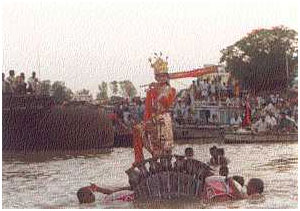 In a performance, Lord Krishna jumps into Ganga for Nag Nathan at the local Tulsi Ghat. It is famous as Nag Nathaiya Leela. Many people congregate to see this event, held during the months of November-December.
In a performance, Lord Krishna jumps into Ganga for Nag Nathan at the local Tulsi Ghat. It is famous as Nag Nathaiya Leela. Many people congregate to see this event, held during the months of November-December.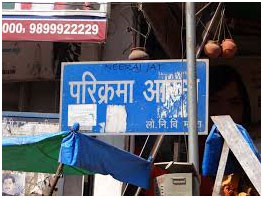 It has a special importance in the ancient Parikrama of India, starting and finishing at ManiKarnika Ghat. Each Parikrama passes through five places: Kardmeshwar, Bhimchandi, Rameshwar, Shivpur & Kapil Dhara.
It has a special importance in the ancient Parikrama of India, starting and finishing at ManiKarnika Ghat. Each Parikrama passes through five places: Kardmeshwar, Bhimchandi, Rameshwar, Shivpur & Kapil Dhara. Ganga Mahotsav, the tourism festival of Varanasi is celebrated every year from Prabodhani Ekadashi to Kartik Purnima in the month of October-November. The festival celebrates the rich cultural heritage of Varanasi. Apart from the excellent cultural programs and country boat race, displaying of martial arts also takes place. The concluding day coincides with the unique traditional festival of Dev Deepavali (light festival of Gods), when more than a million earthen lamps (Diyas) are lit on the Ghats of Ganga.
Ganga Mahotsav, the tourism festival of Varanasi is celebrated every year from Prabodhani Ekadashi to Kartik Purnima in the month of October-November. The festival celebrates the rich cultural heritage of Varanasi. Apart from the excellent cultural programs and country boat race, displaying of martial arts also takes place. The concluding day coincides with the unique traditional festival of Dev Deepavali (light festival of Gods), when more than a million earthen lamps (Diyas) are lit on the Ghats of Ganga.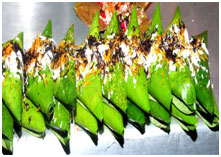



 Many of the ghats were constructed under the patronage of the Marathas, Shindes (Scindias), Holkars, Bhonsles, and Peshwas. A morning boat ride on the Ganges across the ghats is a popular tourist attraction. The extensive stretches of ghats in Varanasi enhance the riverfront with a multitude of shrines, temples, and palaces built “tier on tier above the water’s edge”.
Many of the ghats were constructed under the patronage of the Marathas, Shindes (Scindias), Holkars, Bhonsles, and Peshwas. A morning boat ride on the Ganges across the ghats is a popular tourist attraction. The extensive stretches of ghats in Varanasi enhance the riverfront with a multitude of shrines, temples, and palaces built “tier on tier above the water’s edge”.


 This ghat (old Prayaga Tirtha) together with shrine of Prayagagesvara replicates the existence of Prayaga/ Allahabad in Varanasi.
This ghat (old Prayaga Tirtha) together with shrine of Prayagagesvara replicates the existence of Prayaga/ Allahabad in Varanasi.









